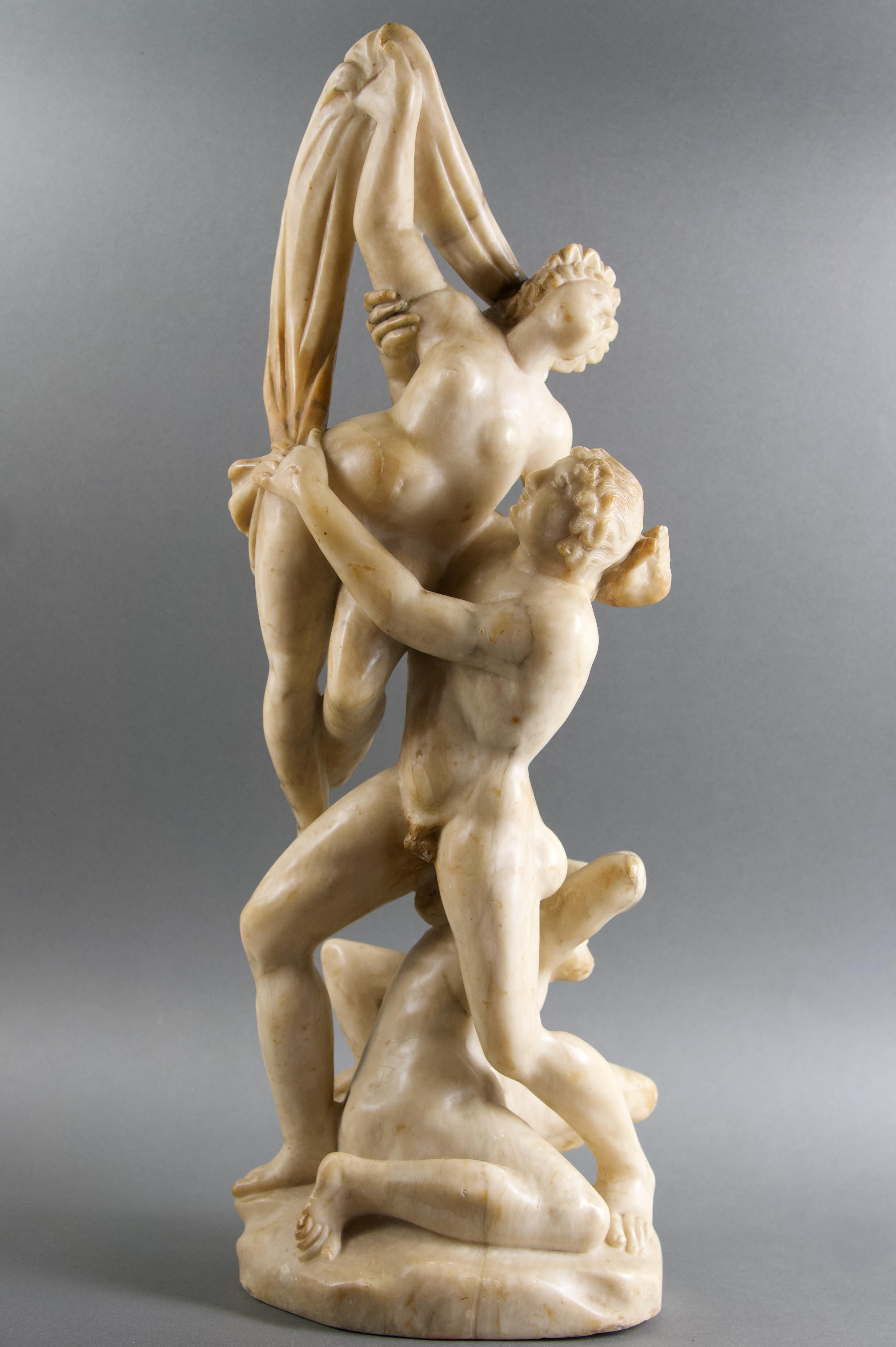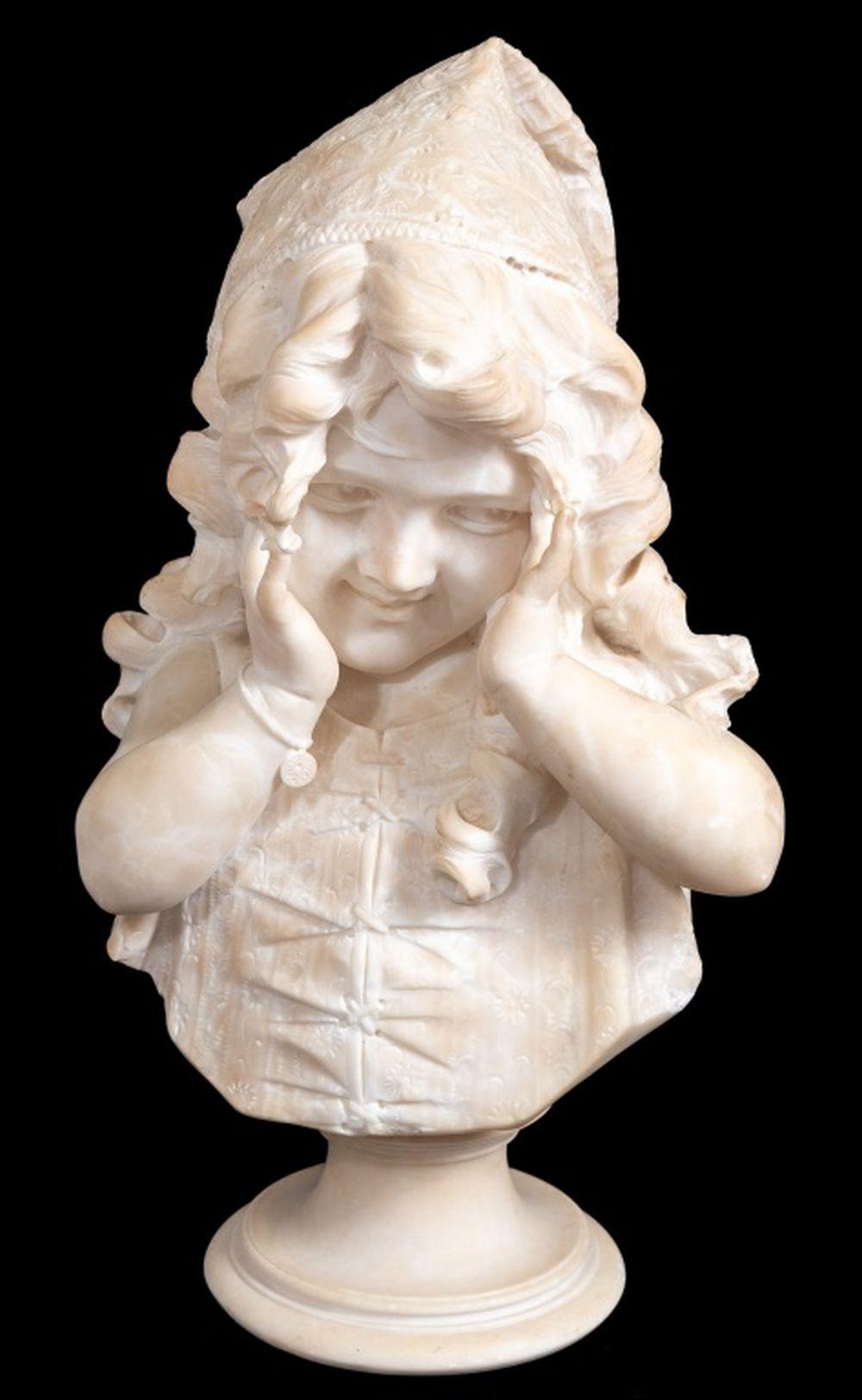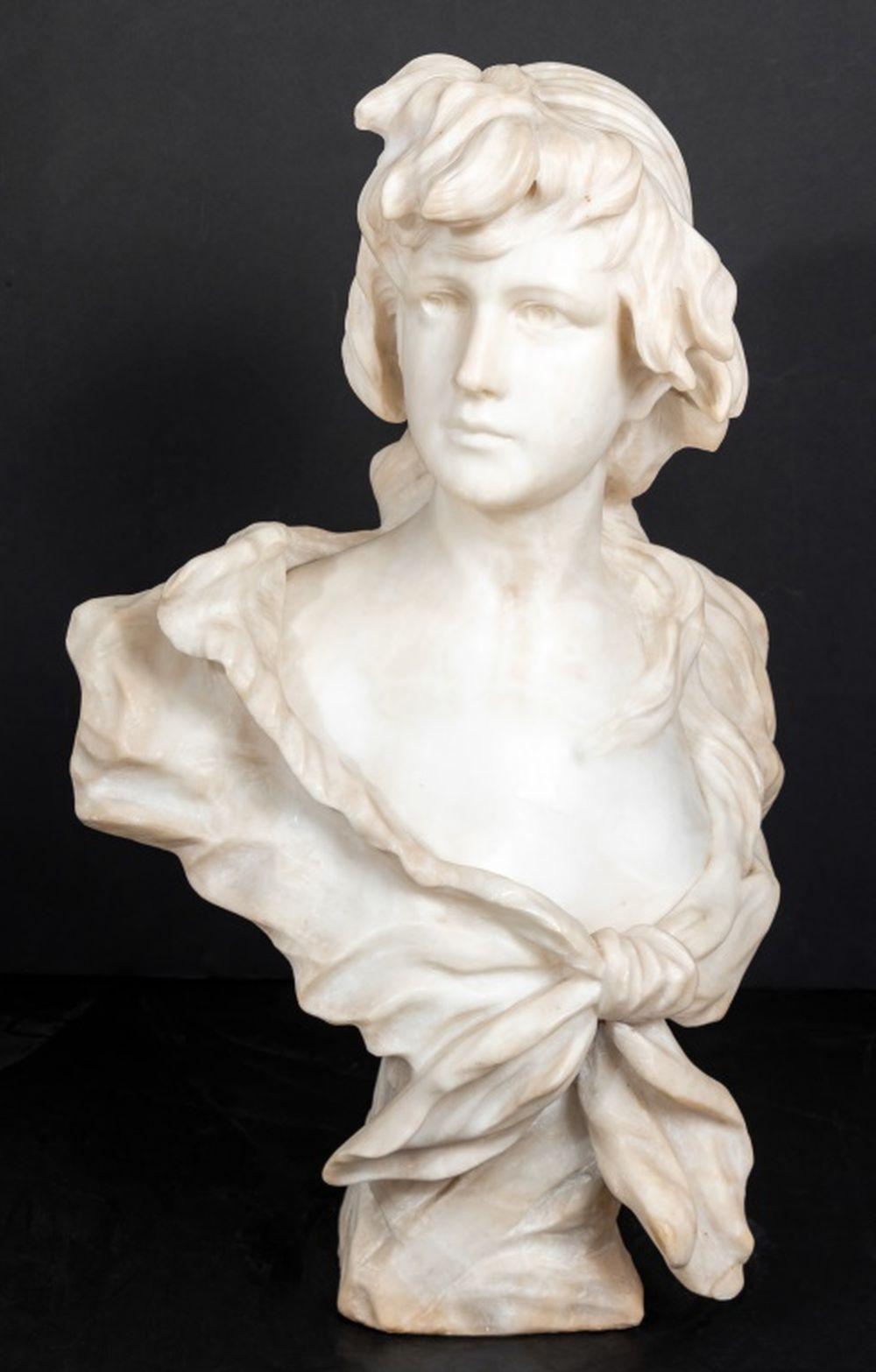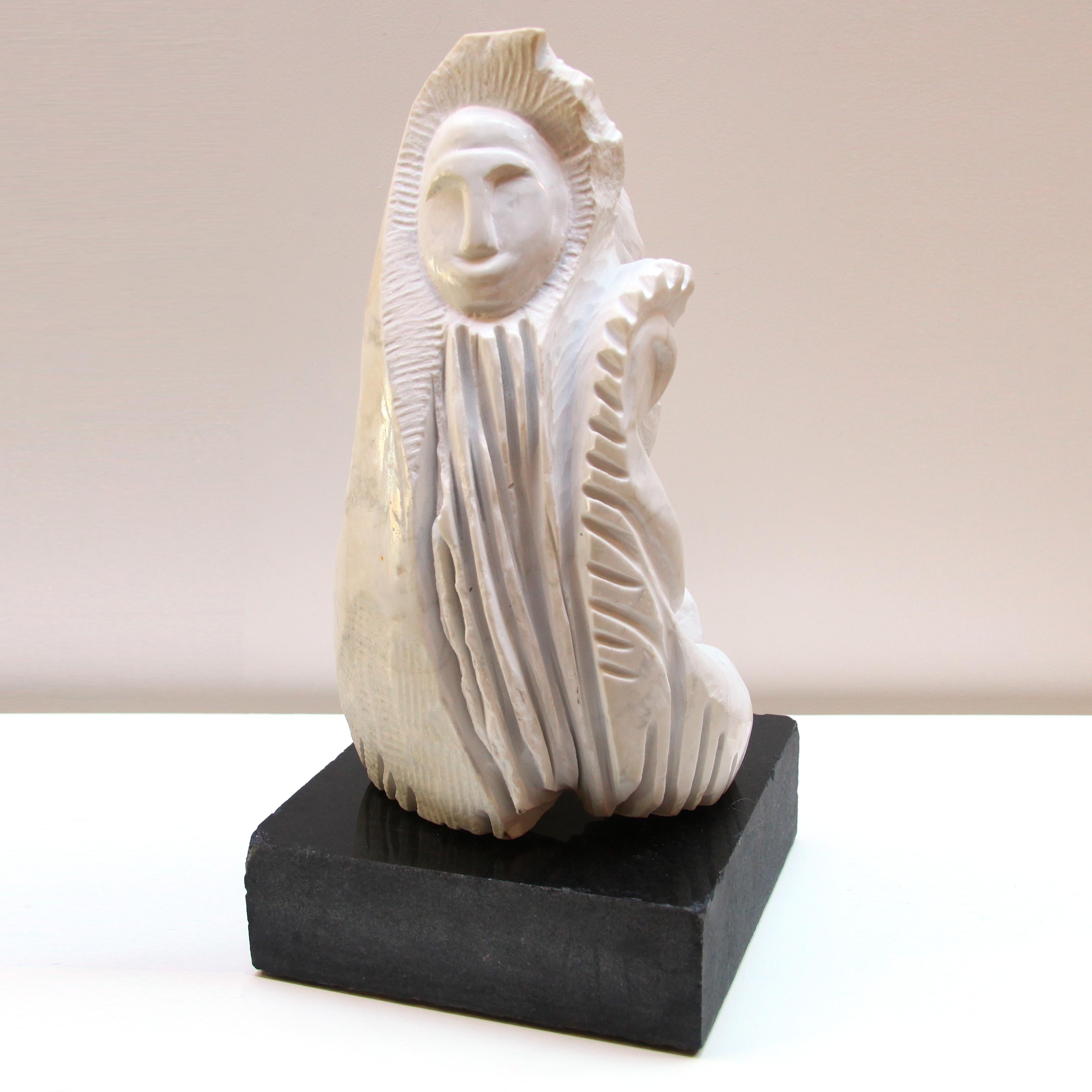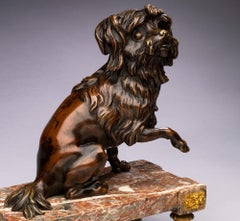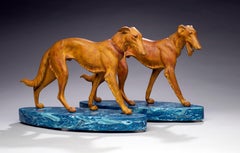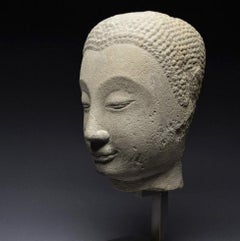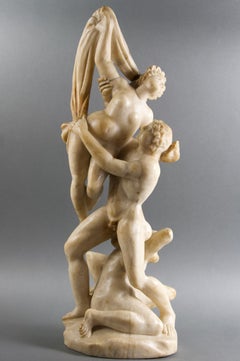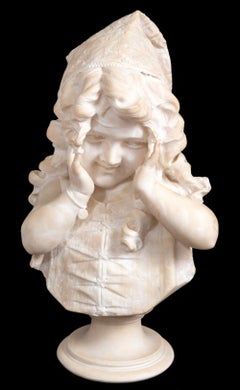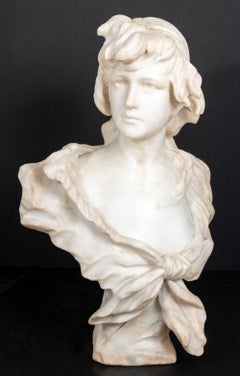Items Similar to Pair of Italian "Alabaster Stone Lions" after Antonio Canova; Mid 19th Century
Want more images or videos?
Request additional images or videos from the seller
1 of 10
UnknownPair of Italian "Alabaster Stone Lions" after Antonio Canova; Mid 19th CenturyCirca 1850
Circa 1850
About the Item
"Pair Recumbent Stone Lions"
after Antonio Canova (1757-1822)
Italian (possibly Florence)
Mid 19th Century
Alabaster, marble
6 x 9 x 4 inches
This is an exquisite pair of Italian alabaster lions on marble bases based on the monumental lions carved by Antonio Canova (1757-1822), the greatest Italian neoclassical sculptor. Canova sculpted the marble lions for the monumental tomb of Pope Clement XIII in St. Peter’s, Rome in 1792
Canova Lions refers to the pair of copies of lion sculptures by Antonio Canova. When Canova created the sculptures in 1792, he installed them on the tomb of Pope Clement XIII. The marble sculptures are some of the most prominent features in St. Peter's Basilica in Rome. Given the intricacies of creating the original Canova lions, some artists created molds and replicated them. A good example is the pair of lion sculptures at the Corcoran Gallery of Art entrance in Washington DC which have stood in their same location since 1860. Canova was able to create such life-like, believable sculptures because as one of the premier artists in 18th-century Rome, he was known for the length of time he spent during the study phase. Canova was so meticulous that when the time came to create a sculpture, he would do it without making any corrections. With his large studio, Canova was able to execute highly-sophisticated projects for rulers like French Emperor Napoleon Bonaparte, European aristocracy and nobility as well as prominent Italian religious figures.
St. Peter's Basilica in the Vatican City is home to exquisite works of art by some of Italy's finest sculptors, including Michelangelo. Like Canova, Michelangelo took part in memorable sculptural and architectural projects. Especially notable examples of Michelangelo's work are the sculpture of David in Florence and the frescoes on the ceiling of the Sistine Chapel. Clearly Canova is in good company regarding his stature as an artist. Having worked for St. Peter's Basilica, he must have made a name for himself and attracted commissions for bigger projects. You only need to see the popularity of the Canova lions to know his impact on the world of art.
By the close examination of the two Canova lions it's possible to derive their meanings. While one lion is sleeping, the other is more vibrant. The combination of the two lions tells us about the Pope's moderate yet determined mien. Before he died, Canova made many copies of the two lions for different clients across the world. Other artists created copies many years after he had died.
The Canova lions have proved to be eternally popular images; copies were made soon after in the workshops of Rome to sell to wealthy ‘Grand Tourists’ as souvenirs from their classical tour. In England, Canova’s greatest patron was the 6th Duke of Devonshire whose seat was at Chatsworth House, Derbyshire. The Grand Tour of the late 17th, 18th and 19th centuries saw many upper class, wealthy and aristocratic gentlemen and ladies traveling to Italy and Europe for pleasure, education and inspiration. This afforded them the opportunity to view important classical and Renaissance works of art and architecture.
The term ‘Grand Tour’ was coined by the Catholic priest and travel writer Richard Lassels (circa 1603-68), who used it in his influential guidebook "The Voyage of Italy," published in 1670, to describe young lords travelling abroad to learn about art, architecture and antiquity. Robert Adam wrote of Rome in 1755, ‘Rome is the most glorious place in the universal world. A grandeur and tranquillity reigns in it, everywhere noble and striking remains of antiquity appear in it, which are so many that one who has spent a dozen years in seeing it is still surprised with something new…’
- Creation Year:Circa 1850
- Dimensions:Height: 6 in (15.24 cm)Width: 9 in (22.86 cm)Depth: 4 in (10.16 cm)
- Medium:
- Movement & Style:
- Period:
- Condition:This pair is in very fine condition and are beautifully carved.
- Gallery Location:SANTA FE, NM
- Reference Number:1stDibs: LU1408211778962
About the Seller
5.0
Platinum Seller
Premium sellers with a 4.7+ rating and 24-hour response times
Established in 1995
1stDibs seller since 2020
111 sales on 1stDibs
Typical response time: <1 hour
- ShippingRetrieving quote...Shipping from: Santa Fe, NM
- Return Policy
Authenticity Guarantee
In the unlikely event there’s an issue with an item’s authenticity, contact us within 1 year for a full refund. DetailsMoney-Back Guarantee
If your item is not as described, is damaged in transit, or does not arrive, contact us within 7 days for a full refund. Details24-Hour Cancellation
You have a 24-hour grace period in which to reconsider your purchase, with no questions asked.Vetted Professional Sellers
Our world-class sellers must adhere to strict standards for service and quality, maintaining the integrity of our listings.Price-Match Guarantee
If you find that a seller listed the same item for a lower price elsewhere, we’ll match it.Trusted Global Delivery
Our best-in-class carrier network provides specialized shipping options worldwide, including custom delivery.More From This Seller
View AllAntique 19th century Bronze Dog Portrait of a Löwchen on a Marble Base
Located in SANTA FE, NM
Antique Bronze Dog Portrait of a Löwchen on a Marble Base
French 19th century
1/2 x 8 x 5 1/2 inches
The chiseled bronze has a nuanced, rich brown patina depicting a Löwchen in the round, seated on a quadrangular marble base decorated with very fine gilt bronze flowers and fluted feet. Napoleon III, Louis XVI style. Based on a model by Jacques Caffieri for the Prince de Condé in 1773.
(More images to be added.)F
Executed during the nineteenth century, this figure is fully in line with the eclectic taste of the reign of Napoleon III. Indeed, the Empress Eugenie brought the Louis XVI style up to date in her castle of Compiègne. Jacques Caffieri is one of the most famous bronze smiths of the eighteenth century. In 1715 he was admitted as a master caster and chiseler, and worked almost exclusively for the crown castles...
Category
19th Century Rococo Figurative Sculptures
Materials
Marble, Bronze
Balancing Elephant, Circa 1930s, Art Deco, Louis-Albert Carvin (1875-1951)
Located in SANTA FE, NM
Balancing Elephant
Louis-Albert Carvin (France, 1875-1951)
Bronze, marble
Circa 1930s, Art Deco
8 x 7.5 x 2 (4 1/4 x 7 1/2 x 1 7/8 figure) inches
Artist Louis-Albert Carvin, born in Paris in 1875, was exposed to art from an early age through his painter father. Carvin's formal education in art began at the École des Beaux-Arts, where he studied under artists like Émmanuel Frémiet and Georges Gardet. Over the years, artist Louis-Albert Carvin became a renowned sculptor, dedicating his life’s work to the modeling of human and animal figures. He studied under Fremiet and Gardet and became a member of the Société des Artistes Français, exhibiting at the Salon des Artists Francais from 1894 until 1933 winning the Medal of Honor in his first year in 1894.
Remarkably, he sculpted La Muse de l’Aviation, the bronze trophy...
Category
1930s Art Deco Figurative Sculptures
Materials
Marble, Bronze
Antique Pair of Russian Wolf Hound/Borzoi Dog Portrait Sculptures circa 1930's
Located in SANTA FE, NM
Antique Pair of Russian Wolfhounds/Borzois Dog Portrait Sculptures
by Scalini (aka Scali; Italian, 20th century)
circa 1930's
Patinated spelter
9 x 14 inches (on bases)
Though rath...
Category
1920s Art Deco Figurative Sculptures
Materials
Cast Stone, Bronze
$3,080 Sale Price
20% Off
Large 17th century, Sandstone Buddha Head from Thailand, Ayutthaya Kingdom
Located in SANTA FE, NM
Large Sandstone Head of Shakyamuni Buddha
Thailand (formerly Siam), Ayutthaya Kingdom
17th century
16 1/2 inches on stand, 11 1/3 without
Private collection, France.
The face is ...
Category
17th Century Other Art Style Figurative Sculptures
Materials
Sandstone
Indian Pink Sandstone Figure of a Deity, Central India, 11th/12th century
Located in SANTA FE, NM
Indian Pink Sandstone Torso of Brahma
Central India, ca. 11th/12th century
Pink Sandstone
22 inches, 25 inches on base
The Hindu deity Brahma c...
Category
15th Century and Earlier Other Art Style Figurative Sculptures
Materials
Sandstone
Antique 19th cent. Dog Portrait Jack Russell Terrier by Pierre-Albert Laplanche
Located in SANTA FE, NM
Antique Bronze Dog Portrait of a Terrier
Pierre-Albert Laplanche (French, 1826-1873)
Signed in script to base "Laplanche"
Stamped "E.V 3753"
8 x 2.75 x 8 1/4 inches
This is a super...
Category
Mid-19th Century Academic Figurative Sculptures
Materials
Bronze
You May Also Like
Italian Neoclassical Sculptural Group in Alabaster "The Rape of the Sabine Women" 18th
Located in Pistoia, IT
"The Rape of the Sabine Women," veined alabaster, large sculptural group with classical subject, Volterra manufacture, 18th century.
The so-called Rape of the Sabine Women is a scu...
Category
1790s Italian School Figurative Sculptures
Materials
Alabaster
Neapolitan Girl
By Emilio Fiaschi
Located in Astoria, NY
Emilio Fiaschi (Italian, 1858-1941) Neapolitan Girl Alabaster Bust, late 19th century, depicting a young girl hiding her face behind her hands, on a socle, signed "E Fiaschi" to back...
Category
Late 19th Century Italian School Figurative Sculptures
Materials
Alabaster
Female Figure Bust
Located in Astoria, NY
Italian School Female Figure Carved Alabaster Bust, late 19th century, the portrait with tied back hair and flowing dress tied at her breast, on a rockwork plinth, unsigned. 26" H x ...
Category
Late 19th Century Italian School Figurative Sculptures
Materials
Alabaster
Large Neoclassical White Marble Sculpture Venus Italica mid-19th century
Located in Pistoia, IT
Venus Italica, imposing sculpture in white Carrara marble, mid-nineteenth-century Roman atelier.
Antonio Canova made several sculptures depicting Venus. The first was made as compen...
Category
Mid-19th Century Italian School Figurative Sculptures
Materials
Marble
Venus Colca Neoclassical Marble Sculpture early 19th century
Located in Pistoia, IT
Crouching Venus, neoclassical Carrara marble sculpture, early 19th century.
An 18th-century English tourist to Florence wrote that of all the Venuses in the Uffizi, "only one grace...
Category
Early 19th Century Italian School Figurative Sculptures
Materials
Marble
Figurative Marble Sculpture, "Kindred"
By TONY GANGITANO
Located in San Diego, CA
This is a one of a kind Italian white Carerra marble sculpture by San Diego artist Tony Gangitano. Its dimensions are 10" x 25" x 10". It is on a black granite base. A certificate of authenticity will follow delivery.
This sculpture is a representation of Mary and Christ...
Category
2010s Italian School Figurative Sculptures
Materials
Granite, Marble
Recently Viewed
View AllMore Ways To Browse
Two Lions
Italian Sculpture Stone
Art Mid Century Pairs Large
Marble Lion
Marble Lions
Antique Lion Sculpture
Lion Dor
Pair Of Stone Sculpture
19th Century Alabaster
Italian Carved Lions
Antique Alabaster Sculpture
Renaissance Art Pairings
Large Lion Sculpture
Large Pair Sculpture Figurative
Sculpture Of Two Lions
Antique Stone Lions
17th Century Lion
Stone Emperor
